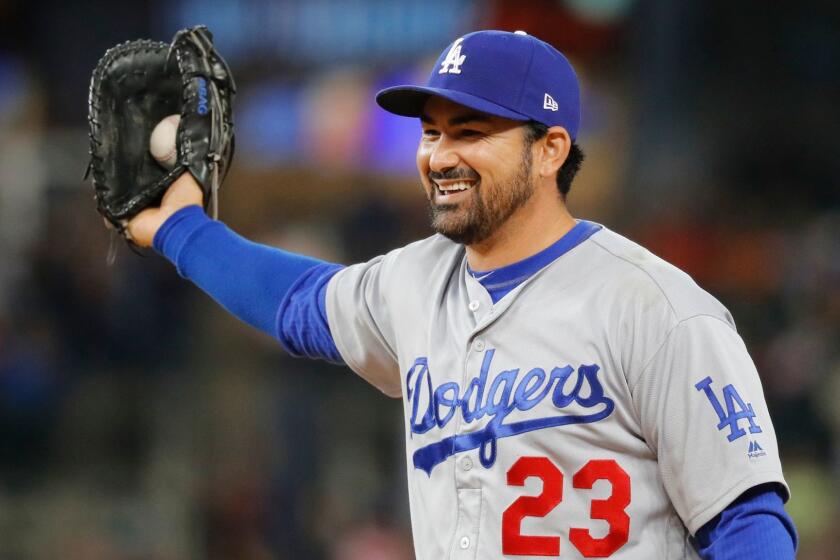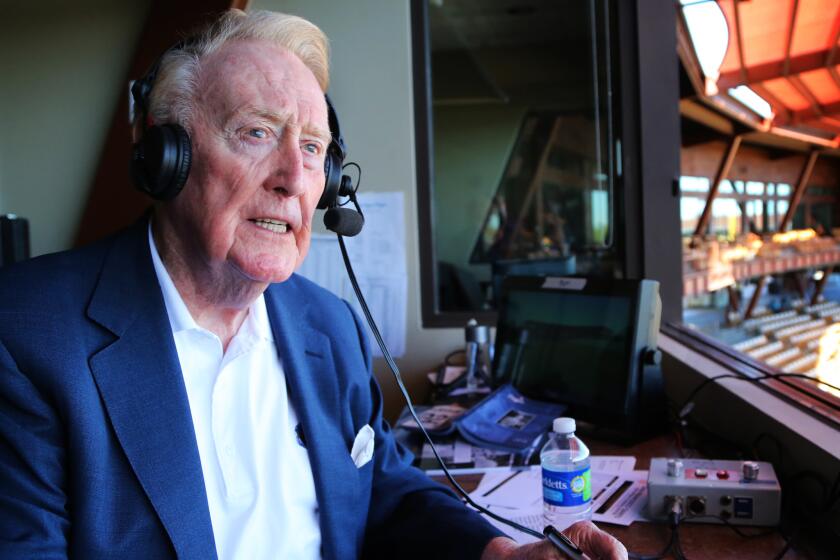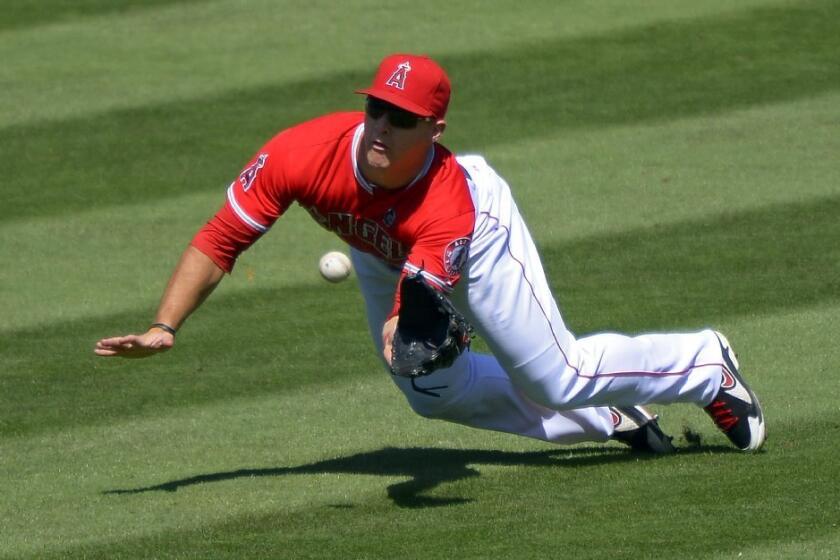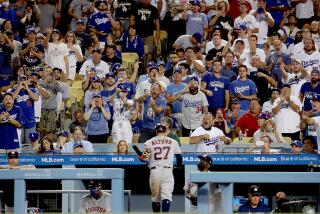Did Astros beat the Dodgers by cheating? The numbers say no
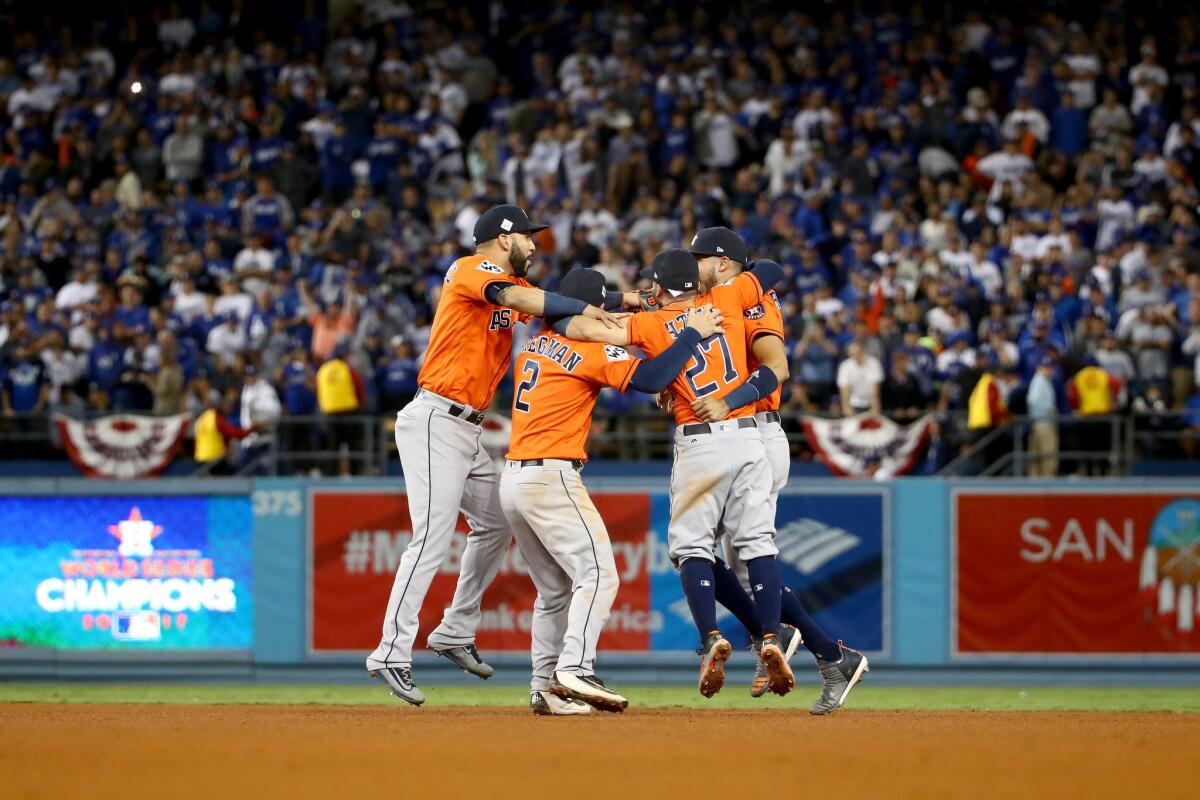
- Share via
The narrative surrounding the Houston Astros’ cheating in 2017 and 2018 has become well-established since Baseball Commissioner Rob Manfred laid out the details and parceled out punishments on Jan. 13.
The team, Manfred announced, transmitted images from a center field camera to a video monitor to steal signs from opposing catchers, and signaled its batters what was coming by banging on a trash can.
The impression left with the average fan and many pro ballplayers is that this gave the Astros a huge advantage at the plate, enough to propel them to a World Series victory over the Dodgers in 2017.
It’s like a morality play. They put in all this work, and it ends up getting them right back to where they started.
— Statistician Robert Arthur
Though Manfred banned Astros Manager A.J. Hinch and General Manager Jeff Luhnow for a year (the team fired both the same day), he stopped short of revoking the Astros’ championship.
Nevertheless, the 2017 Series win is hopelessly tainted. Sentiment remains rife in Los Angeles that the Dodgers wuz robbed. At least one opposing pitcher feels that a bad outing against the cheaters ruined his career, and he’s filed a lawsuit.
But things aren’t that simple. This won’t be a popular conclusion in Dodgertown, but new analyses of the Astros’ 2017 season by baseball’s corps of unofficial statisticians — “sabermetricians,” to the sport — indicate that the Astros didn’t gain anything from their cheating; in fact, it may have hurt them.
The most comprehensive analysis, and the most explicit finding, comes from Robert Arthur, who posts at the statistical website Baseball Prospectus.
Arthur is a data scientist who also has worked at the statistics site FiveThirtyEight.com, where he established that a change in the baseballs used in the major leagues contributed to a jump in home run rates, a finding later confirmed by Major League Baseball’s own investigation.
Arthur’s analysis resembles those of some other experts who have found either a very modest gain from the cheating or one that’s virtually impossible to quantify in the real world.
“You are so damned dumb,” then-Commissioner Peter Ueberroth told Major League Baseball team owners at a meeting in 1985.
“The net effect of the banging comes astonishingly close to being zero,” Arthur wrote on Jan. 30. “Nothing. Statistically, for all the work and effort that went into the cheating scheme, the grand result of it ... turned out to be no runs at all.”
“It’s like a morality play,” Arthur told me. “They put in all this work, and it ends up getting them right back to where they started. It makes you wonder whether if they had devoted that effort to just being better baseball players or hitting better to begin with, maybe they would have actually come out ahead and been an even better team than they were.”
Before examining how Arthur reached his conclusion, let’s stipulate that it doesn’t absolve the Astros. Manifestly they broke the rules, which bar the use of electronic assistance to steal signs. (Stealing signs by natural means is legal.) They did so even after Manfred explicitly warned every team against the practice, and stated that he would exact punishment on any field and general managers found to have allowed it.
There’s something to be said for much harsher punishment — and historian Sean Wilentz has said it: All the participating players should be permanently banished from the game.
Wilentz poses the precedent laid down by Baseball Commissioner Kenesaw Mountain Landis, who in 1920 banished eight members of the White Sox for having thrown the 1919 World Series for gamblers. Landis’ decree covered the great “Shoeless” Joe Jackson, who hadn’t participated in the plot and in fact played superbly during the Series, but who knew of it and remained silent.
“Landis may have been draconian, but he kept the game above suspicion of being rigged,” Wilentz observes. Landis’ actions are a reproach to Manfred, who issued blanket immunity to the Astros players.
“Until and unless Commissioner Manfred lifts his ludicrous immunity offer and deals severely with the incriminated participating players as well as their management by banishing them all from the game, he will have thrown baseball back to where it was in 1919.”
Manfred, Wilentz writes, “has history on his side.” If he were to follow through, his ban would extend to Astros second baseman Jose Altuve, who has said he didn’t participate in the cheating — a claim Arthur finds credible — but who knew about it and kept mum.
The Astros’ grudging half-apologies, as well as their intimation that their sign-stealing didn’t actually affect the game, has intensified discontent with Manfred’s approach as well as the conviction that they probably couldn’t have won without cheating.
Now let’s look at the numbers.
Almost as soon as Ken Rosenthal and Evan Drellich of the Athletic exposed the Astros’ cheating on Nov. 12, the sport’s sabermetricians went to work on the team’s record. (The term derives from the Society for American Baseball Research, or SABR, which was formed in 1971 to bring together historians, statisticians and fans to scrutinize the immense accumulation of data on pitching, batting, and everything else associated with the game.)
The problem, at first, was that data were lacking on when the scheme actually started and how it was used in the game. All that was really known was that in 2017, including the post-season, and at least part of 2018, the Astros used a center field camera at their home field, Minute Maid Park, to watch opposing catchers lay down signs for the pitchers, and relayed the images to a monitor by the Astros dugout.
Once decoded, this told the team whether the next pitch was a fastball or a breaking ball. The information was signaled to the batter by bangs on a trashcan. A bang or two meant a breaking ball, no bang meant fastball. Other means of signaling may also have been used.
Without knowing how the scheme was executed pitch by pitch, the analysts examined how the Astros performed generally in 2017 and 2018, compared to 2016. They found that, among other things, the Astros showed a huge improvement in avoiding strikeouts — going from the fourth-worst strikeout rate in the major leagues in 2016, to the best in baseball the following year.
As one of the increasingly demoralized fans of the Los Angeles Angels, I took the latest news about Shohei Ohtani almost in stride.
“They struck out so much less, it’s fair to use the word ‘historic’ to describe it,” reported Jayson Stark and Eno Sarris in the Athletic.
Lots of factors go into success at the plate, however. Although the strikeout improvement was consistent with getting signals about incoming pitches, it also was consistent with a change in the Astros’ lineup.
Alex Bregman and Yuli Gurriel were playing their first full seasons in 2017, and the team also added several players with “a track record of making more contact than the players they replaced.” The team was expected to have a lower strikeout rate in 2017, though the scale of the improvement was unexpected — and unprecedented.
“How much of the Astros’ championship season was about greatness, and how much was about sign-stealing?” Stark and Sarris wrote. “We would love to tell you. But repeat after us: We. Have. No. Idea.”
As it happened, about the same time they wrote that, the data gap was filled by one Tony Adams, a self-described Astros fan. Adams watched every home game for which there was available video and logged every pitch, matching them against audio to detect the bangs. That produced a database of more than 8,200 pitches from 58 games, which he posted online at the end of January.
Statisticians have been mining the data ever since.
As parsed by Arthur, the data showed that the Astros appeared to provide bangs for their batters about 70% of the time. The fewest bangs occurred in the first inning — presumably because it took time for the schemers to decode the catchers’ signs, and the rate then declined from the second through the ninth. Arthur posits that this was because pitchers got a whiff of the sign-stealing or relievers came onto the mound, requiring new rounds of decoding.
Most importantly, the signaling was not perfectly accurate. Arthur calculates that bangs accurately foretold breaking pitches 93% of the time, and no-bangs foretold fastballs only 65% of the time.
That’s key, because a wrong signal hurt immensely more than a correct signal helped. On correctly-signaled pitches, the Astros as a team improved their batting average by seven points, to .289, and their slugging percentages (total bases divided by at-bats) by 25 points, to .503. As Arthur wrote, “25 points of slugging is a material boost.” On-base percentage didn’t change.
But on wrongly-signaled pitches, the damage was severe. They lost 45 points of batting average, 52 points of on-base percentage and 93 points of slugging — “certainly much worse than the incredibly-talented 2017 Astros lineup should have been able to hit,” Arthur wrote.
Such an asymmetric result isn’t unusual in baseball. Take base-stealing: A team gains much from a successful stolen base, since it puts a man in scoring position. But it loses much more if the runner is caught stealing — that takes a man off the basepaths and costs an out. For that reason, sabermetrics dictates that if a base-stealer isn’t successful at least 60% of the time, he should stay at first.
Never mind the crocuses in bloom or the red red robin bobbin’ along.
It’s possible that the Astros’ scheme harmed them by imprisoning some batters in the expectation of perfect information. Arthur finds that the Astros did worse against some pitches with men on base than when the basepaths were clear, probably because pitchers switched their signs with men on, forcing the Astros to decode all over again while their batter struggled with no signal.
As for Altuve, Arthur concludes that it’s true that Altuve shunned the cheating. He received the fewest bangs of any full-time Astro batter, and his statistics don’t show the sort of batting that would reflect the knowledge of what was coming.
There’s been speculation that Altuve received signals some other way, such as a buzzer concealed under his uniform, but Arthur believes his denials. He does point out, however, that Altuve may have benefited indirectly from the cheating.
“He may have been harvesting the rewards of overperformance from others in the lineup,” Arthur writes: “More men on base ahead of him, more lineup protection behind him, more fatigued pitchers facing him, and so on.”
Arthur, and others, acknowledge that there are still limits to what is known about the cheating. Manfred intimated that the trashcan banging wasn’t the only means of communicating signs to the batters — whistles, yells or shouts may also have been used, none of which are mapped in Adams’ database. If those were more accurate than the banging, the Astros may have gained more than it seems. But there’s no reason to assume they would be.
Arthur also notes that when broken down to the player or at-bat level, the cheating may well have helped individual Astros. And it’s possible that a terrible outing against the Astros on Aug. 4, 2017 — four runs, four hits and three walks in one-third of an inning — did write finis to the career of pitcher Mike Bolsinger, then of the Toronto Blue Jays, who has sued the Astros. By then, Bolsinger was a middle of the pack reliever with the end of his career in sight, but that shellacking couldn’t have helped.
In the aggregate, when converted into potential runs or wins, the evidence doesn’t show that the 2017 Astros ended the season ahead of where they might have been anyway. It’s worth remembering how complicated the task of batting a pitched ball is.
“Even if the mystery about what pitch is being thrown is eliminated, there are still a host of other variables to account for (break, location, count, etc.),” wrote Jeff Wiser on Baseball Prospectus. “There’s a lot that still has to transpire before a shared sign results in a well-batted ball with a favorable outcome. Those wrinkles will forever complicate any assessment of Houston’s gains.”
That’s an argument against taking a step such as marking the Astros’ 2017 Series win with an asterisk or even revoking it, as some have argued Manfred should do. The what-ifs will place an asterisk on the Astros’ 2017 and 2018 seasons where it belongs — in the individual memories and judgments of fans and historians.
The Astros were known as a data-driven team in the modern style. Manfred’s investigation and other evidence indicates that other teams were wise to the Astros’ cheating even in 2017, and some were taking counter-measures that made the scheme less effective.
“I wonder why, if it wasn’t helping, why they kept doing it,” Arthur told me. “It does seem like there was a big cost to continuing, which ended up manifesting when they got caught. It was all for very low benefit.”
The greatest cost, of course, was reputational. World Series champions typically keep the halo of heroes all their lives. For the 2017 Astros, that halo is gone forever.
More to Read
Inside the business of entertainment
The Wide Shot brings you news, analysis and insights on everything from streaming wars to production — and what it all means for the future.
You may occasionally receive promotional content from the Los Angeles Times.

